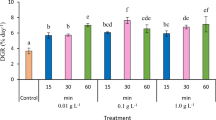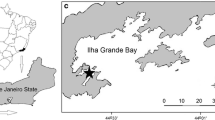Abstract
An optimization study on concentration (viz. 0.01, 0.1, and 1.0 g L−1) and dipping time (i.e., 30 and 60 min) was conducted on three different color morphotypes (i.e., reddish brown, yellowish brown and purple) of the commercial carrageenophyte Kappaphycus alvarezii (Doty) Doty. The study tested the efficacy of Acadian Marine Plant Extract Powder (AMPEP) on the growth rate and occurrence of macro-epiphytes from August to November, representing the wet season of the Philippines. The optimum concentration and dipping time were obtained at 0.1 g L−1 and 30 min, respectively. These optimum parameters were then further verified in a commercial nursery using the yellowish brown morphotype. In another experiment, K. alvarezii (tambalang purple morphotype) and Kappaphycus striatum (Schmitz) Doty (sacol green morphotype) with, and without, AMPEP dippings were tested for their total phenolic content, free radical scavenging and iron chelating activities. Seaweed dipped in AMPEP demonstrated higher growth rates than the control. Lower concentrations (i.e., 0.01-0.1 g L−1) and shorter dipping time (e.g., 30 min) produced higher growth rates than the highest concentration (1.0 g L−1) and longer (60 min) dipping time. The presence of macro-epiphytes such as filamentous Ulva did not adversely affect the robust growth of the three color morphotypes of K. alvarezii. The lowest and highest growth rates obtained in a commercial seaweed nursery using the optimum concentration and dipping time of AMPEP were observed in July and January with 0.8% and 6.7% day−1, respectively. The antioxidant content of K. alvarezii (tambalang purple) and K. striatum (sacol green) responded differently to AMPEP dipping. The changes in total antioxidant activity followed almost the same trend as in phenolic content, in both K. alvarezii (tambalang purple) and K. striatum (sacol green), whereas, the iron chelating ability of both seaweeds with and without AMPEP dipping varied monthly. The results obtained for the use of AMPEP dips for commercial Kappaphycus cultivation demonstrated an effective management tool for improved farming protocols.







Similar content being viewed by others
References
Allen VG, Pond KR, Saker KE, Fontenot JP, Bagley CP, Ivy RL, Evans RR, Brown CP, Miller MF, Montgomery JL, Dettle TM, Wester DB (2001) Tasco-Forage: III. Influence of a seaweed extract on performance, monocyte immune cell response, and carcass characteristics in feedlot-finished steers. J Anim Sci 79:1032–1040
Blunden GT, Jenkins T, Liu YW (1997) Enhanced chlorophyll levels in plants treated with seaweed extract. J Appl Phycol 8:535–543
Borlongan IAG, Tibubos KR, Yunque DAT, Hurtado AQ, Critchley AT (2011) Impact of AMPEP on the growth and occurrence of epiphytic Neosiphonia infestation on two varieties of commercially cultivated Kappaphycus alvarezii grown at different depths in the Philippines. J Appl Phycol 23:615–621
Craigie JS (2011) Seaweed extract stimuli in plant science and agriculture. J Appl Phycol 23:371–393
Critchley AT, Largo D, Wee W, Bleicher L’honneur G, Hurtado AQ, Schubert J (2004) A preliminary summary on Kappaphycus farming and the impact of epiphytes. Jap J Phycol (Supplement) 52:231–232
Crouch IJ, Van Staden J (1992) Effect of seaweed concentrate on the establishment and yield of greenhouse tomato plants. J Appl Phycol 4:291–296
Crouch IJ, Van Staden J (1993) Evidence for the presence of plant growth regulators in commercial seaweed products. Plant Growth Reg 13:21–29
Crouch IJ, Beckett RP, Van Staden J (1990) Effect of seaweed concentrate on the growth and mineral nutrition of nutrient stressed lettuce. J Appl Phycol 2:269–272
Dawes CJ, Lluisma AO, Trono GC (1994) Laboratory and field growth studies of commercial strains of Eucheuma denticulatum and Kappaphycus alvarezii in the Philippines. J Appl Phycol 6:21–24
Fan D, Hodges DM, Zhang JZ, Kirby CW, Ji XH, Locke SJ, Critchley AT, Prithiviraj B (2011) Commercial extract of the brown seaweed Ascophyllum nodosum enhances phenolic antioxidant content of spinach (Spinacia oleracea L.) which protects Caenorhabditis elegans against oxidative and thermal stress. Food Chem 124:195–202
Ferreira MI (2002) The efficacy of liquid extract on the yield of canola plants. South African J Plant Soil 19:159–161
Heimler D, Isolani L, Vignolini P, Tombelli S, Romani A (2007) Polyphenol content and antioxidative activity in some species of freshly consumed salads. Agri Food Chem 55:1724–1729
Hurtado AQ, Critchley AT, Trespoey A, Bleicher-Lhonneur G (2006) Occurrence of Polysiphonia epiphytes in Kappaphycus farms at Calaguas Is. Camarines Norte, Philippines. J Appl Phycol 18:301–306
Hurtado AQ, Bleicher-Lhonneur G, Critchley AT (2008) Kappaphycus ‘cottonii’ farming (Revised Ed.). Cargill Texturizing Solutions, Cargill, Rue de Seves, Baupte, France. 26 pp
Hurtado AQ, Yunque DA, Tibubos K, Critchley AT (2009) Use of Acadian marine plant extract powder from Ascophyllum nodosum in tissue culture of Kappaphycus varieties. J Appl Phycol 21:633–639
Khan W, Rayirath UP, Subramanian S, Jithesh MN, Rayorath P, Hodges DM, Critchley AT, Craigie JS, Norrie P, Prithiviraj B (2009) Seaweed extracts as biostimulants of plant growth and development. J Plant Growth Regul 28:386–399
Jayaraj J, Wan A, Rahman M, Punja ZK (2008) Seaweed extract reduces foliar fungal disease on carrot. Crop Prot 10:1360–1366
Jayaraj J, Norrie J, Punja ZK (2011) Commercial extract from brown seaweed Ascophyllum nodosum reduces fungal diseases in greenhouse cucumber. J Appl Phycol 23:353–361
Kowalski B, Jager AK, Van Staden J (1999) The effect of a seaweed concentrate on the in vitro growth and acclimatization of potato plantlets. Potato Res 42:131–139
Loureiro RR, Reis RP, Critchley AT (2009) In vitro cultivation of three Kappaphycus alvarezii (Rhodophyta, Areschougiaceae) variants (green red and brown) exposed to commercial extract of the brown alga Ascophyllum nodosum (Fucaceae, Ochrophyta). J Appl Phycol 22:101–104
Loureiro RR, Reis RP, Berrogain FD, Critchley AT (2011) Extract powder from the brown alga Ascophylum nodosum (Linnaeus) Le Jolis (AMPEP): a “vaccine-like” effect on Kappaphycus alvarezii (Doty) Doty ex P.C. Silva. J Appl Phycol (doi:10.1007/s10811-011-9735-7)
Mckinnon SL, Hiltz D, Ugarte R, Craft CA (2010) Improved methods of analysis for betaines in Ascophyllum nodosum and its commercial seaweed extracts. J Appl Phycol 22:489–494
Neish IC (2008) Overview of seaweed in the world and Indonesia seaweed prospects. Paper presented at the 1st Indonesia Seaweed Forum, Oct 27–30, 2008, Makassar, Indonesia (Abstract only)
Rayorath PM, Khan W, Palanisamy R, MacKinnon SL, Stefanova R, Hankins SD, Critchley AT, Prithiviraj B (2008a) Extracts of the brown seaweed Ascophyllum nodosum induce gibberellic acid (GA3)-independent amylase activity in barley. J Plant Growth Regul 27:370–379
Rayorath PM, Narayanan JM, Farid A, Khan W, Palanisamy R, Hankins SD, Critchley AT, Prithiviraj B (2008b) Rapid bioassays to evaluate the plant growth promoting activity of Ascophyllum nodosum (L.) Le Jol. using a model plant, Arabidopsis thaliana. J Appl Phycol 20:423–429
Robertson-Anderson DV, Leitao D, Bolton JJ, Anderson RJ, Njobeni A, Ruck K (2006) Can kelp extract (KELPAK) be useful in seaweed mariculture? J Appl Phycol 18:315–321
Singh RP, Muthy KNC, Jayaprakasha GK (2002) Studies on the antioxidant activity of pomegranate (Pinica granatum) peep and seed extracts using in vitro models. J Agri Food Chem 50:81–86
Solis JL, Draeger S, dela Cruz TEE (2010) Marine-derived fungi from Kappaphycus alvarezii and K. striatum as potential causative agents of ice-ice disease in farmed seaweed. Bot Mar 53:587–594
Stirk WA, Van Staden J (1997) Comparison of cytokinin- and auxin-like activity in some commercially used seaweed extract. J Appl Phycol 8:503–508
Stirk WA, Arthur GD, Lourens AF, Novak O, Strnad M, Van Staden J (2004) Changes in cytokinin and auxin concentrations in seaweed concentrates when stored at an elevated temperature. J Appl Phycol 16:31–39
Tisera WL, Naguit MR (2009) Ice-ice disease occurrence in seaweed farms in Bais Bay, Negros Oriental and Zamboanga del Norte. The Threshold 4:1–16
Ugarte R, Sharp G (2001) A new approach to seaweed management in Eastern Canada: the case of Ascophyllum nodosum. Cah Biol Mar 42:63–70
Ugarte R, Sharp GJ, B. Moore B (2006) Changes in the brown seaweed Ascophyllum nodosum (L.) le Jol, plant morphology and biomass produced by cutter rake harvests in southern New Brunswick, Canada. J Appl Phycol 18: 351-359
Yunque DA, Tibubos KR, Hurtado AQ, Critchley AT (2011) Optimization of culture conditions for tissue culture production of young plants of carrageenophyte Kappaphycus. J Appl Phycol 23:433–438
Zhang X, Ervin EH (2004) Cytokinin-containing seaweed and humic acid extracts associated with creeping bent grass leaf cytokinins and drought resistance. Crop Sci 44:1737–1745
Acknowledgment
The senior author is thankful to Acadian Seaplants Limited, Nova Scotia, Canada for the samples of AMPEP used in the study and the farmers of Kasanyangan Nursery Seaweed Enterprise of Zamboanga City for their assistance during sampling days.
Author information
Authors and Affiliations
Corresponding author
Rights and permissions
About this article
Cite this article
Hurtado, A.Q., Joe, M., Sanares, R.C. et al. Investigation of the application of Acadian Marine Plant Extract Powder (AMPEP) to enhance the growth, phenolic content, free radical scavenging, and iron chelating activities of Kappaphycus Doty (Solieriaceae, Gigartinales, Rhodophyta). J Appl Phycol 24, 601–611 (2012). https://doi.org/10.1007/s10811-011-9785-x
Received:
Revised:
Accepted:
Published:
Issue Date:
DOI: https://doi.org/10.1007/s10811-011-9785-x




